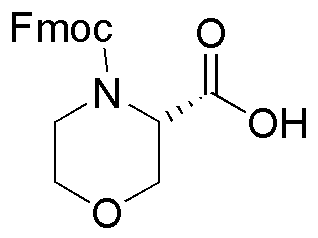(S)-4-N-Fmoc-3-morpholinecarboxylic acid is widely utilized in research focused on
- Peptide Synthesis: This compound serves as a protecting group in the synthesis of peptides, allowing for selective reactions without interference from other functional groups.
- Drug Development: It plays a crucial role in the design of pharmaceutical compounds, particularly in the development of biologically active molecules that target specific diseases.
- Bioconjugation: The chemical is used in bioconjugation processes, facilitating the attachment of biomolecules to surfaces or other molecules, which is essential in creating targeted drug delivery systems.
- Research in Organic Chemistry: It is a valuable reagent in organic synthesis, enabling chemists to explore new reaction pathways and develop innovative synthetic methodologies.
- Material Science: The compound can be utilized in the development of advanced materials, including polymers and coatings, that require specific chemical functionalities for enhanced performance.
General Information
Properties
Safety and Regulations
Applications
(S)-4-N-Fmoc-3-morpholinecarboxylic acid is widely utilized in research focused on
- Peptide Synthesis: This compound serves as a protecting group in the synthesis of peptides, allowing for selective reactions without interference from other functional groups.
- Drug Development: It plays a crucial role in the design of pharmaceutical compounds, particularly in the development of biologically active molecules that target specific diseases.
- Bioconjugation: The chemical is used in bioconjugation processes, facilitating the attachment of biomolecules to surfaces or other molecules, which is essential in creating targeted drug delivery systems.
- Research in Organic Chemistry: It is a valuable reagent in organic synthesis, enabling chemists to explore new reaction pathways and develop innovative synthetic methodologies.
- Material Science: The compound can be utilized in the development of advanced materials, including polymers and coatings, that require specific chemical functionalities for enhanced performance.
Documents
Safety Data Sheets (SDS)
The SDS provides comprehensive safety information on handling, storage, and disposal of the product.
Product Specification (PS)
The PS provides a comprehensive breakdown of the product’s properties, including chemical composition, physical state, purity, and storage requirements. It also details acceptable quality ranges and the product's intended applications.
Certificates of Analysis (COA)
Search for Certificates of Analysis (COA) by entering the products Lot Number. Lot and Batch Numbers can be found on a product’s label following the words ‘Lot’ or ‘Batch’.
Número de catálogo
Número de lote/lote
Certificates Of Origin (COO)
This COO confirms the country where the product was manufactured, and also details the materials and components used in it and whether it is derived from natural, synthetic, or other specific sources. This certificate may be required for customs, trade, and regulatory compliance.
Número de catálogo
Número de lote/lote
Safety Data Sheets (SDS)
The SDS provides comprehensive safety information on handling, storage, and disposal of the product.
DownloadProduct Specification (PS)
The PS provides a comprehensive breakdown of the product’s properties, including chemical composition, physical state, purity, and storage requirements. It also details acceptable quality ranges and the product's intended applications.
DownloadCertificates of Analysis (COA)
Search for Certificates of Analysis (COA) by entering the products Lot Number. Lot and Batch Numbers can be found on a product’s label following the words ‘Lot’ or ‘Batch’.
Número de catálogo
Número de lote/lote
Certificates Of Origin (COO)
This COO confirms the country where the product was manufactured, and also details the materials and components used in it and whether it is derived from natural, synthetic, or other specific sources. This certificate may be required for customs, trade, and regulatory compliance.


